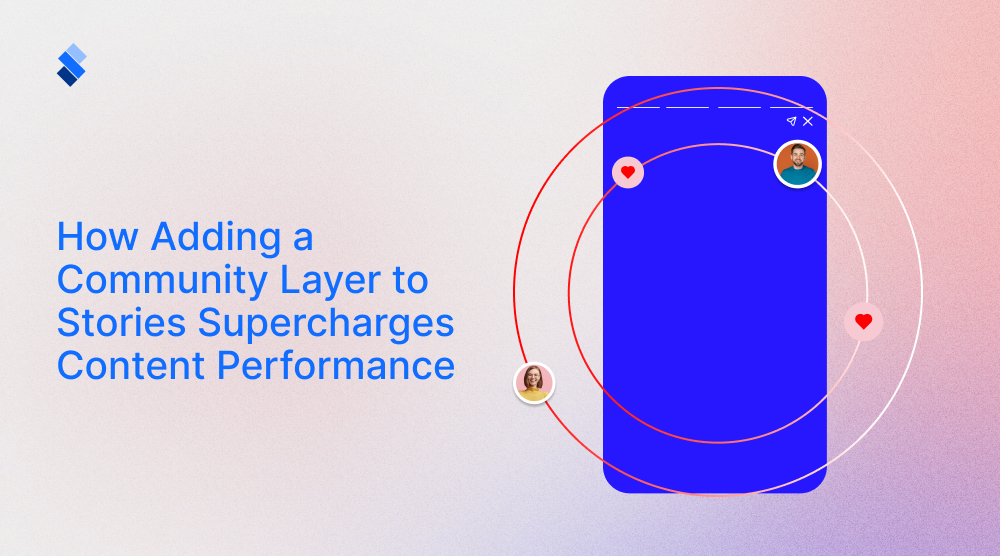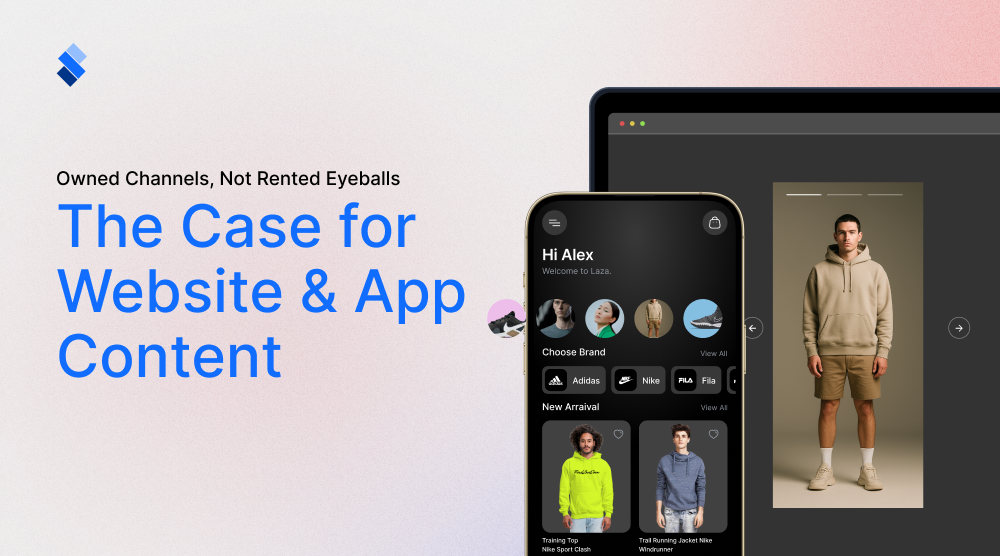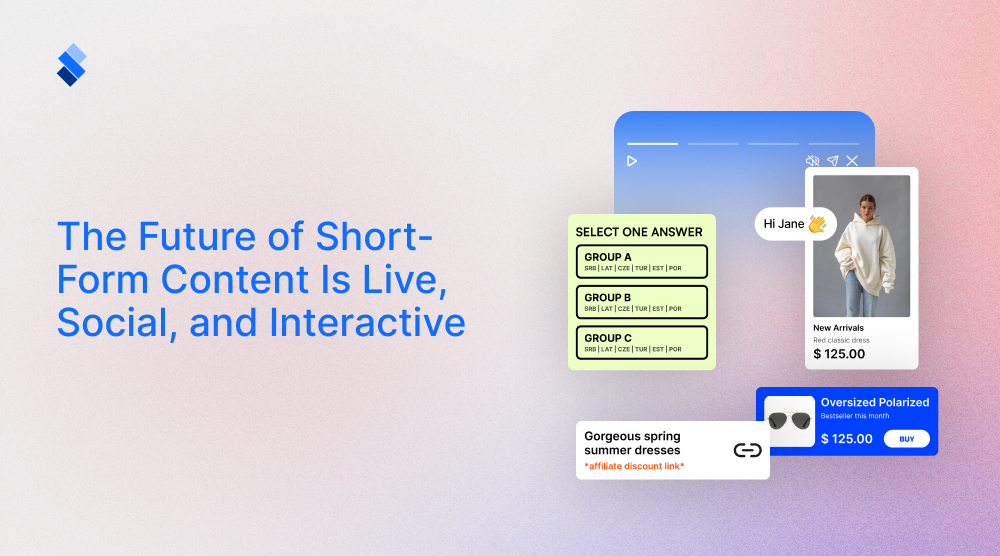How Adding a Community Layer Supercharges Your Content Performance
Discover how adding a community layer transforms your content from a monologue into a dialogue. Learn practical strategies to boost engagement, build loyalty, and drive growth by authentically connecting with your audience.

For years, the marketing playbook has been relatively straightforward. You create high-quality content, publish it across various channels, and hope it attracts an audience. It’s a one-way broadcast, one might even say a monologue, into the digital void. And while good content is still essential, it's no longer enough to break through the noise. Fortunately, the more forward-thinking brands have discovered a great solution. Transforming their content from a standalone asset into the centerpiece of a community experience. As it turns out, this shift from broadcast to community is no longer just a "nice-to-have" alternative, but a necessary step in audience engagment.
The value of adding a community layer
Right off the bat, let’s establish that standard content still has a role to play. Just because you can add a community layer doesn’t mean that you absolutely have to. But, if you understand the value of adding a community layer, and when it makes sense to do so, you can boost your overall content performance to a surprising degree.
Harness the power of authenticity
It is fair to say that the modern consumer is ad-weary and sceptical. Years of watching marketing content has lead them to inherently distrust what brands say about themselves. But, they do trust what other people say. Especially if they speak from experience.

A vibrant community serves as a perpetual engine for authentic, earned media. With 92% of consumers trusting recommendations from people like them over any form of advertising, your community members become your most credible and effective sales force. This isn't just a theary. The proof lies in conversion rates. User-generated content (UGC) from active communities drives a 4.5% higher conversion rate than polished brand content. Furthermore, brands with active communities see a 7x higher lift in brand awareness, meaning your members are constantly expanding your reach and attracting new customers. And they do so in a way that feels genuine and trustworthy.
Increasing Customer Lifetime Value
Acquiring a customer is one thing. Keeping them is where the real profit lies. Well, a community is the ultimate tool for retention, transforming one-time buyers into lifelong, loyal fans. The data here is striking: customers who feel a sense of community are 5x more likely to purchase again and 7x more likely to become vocal brand advocates. This emotional connection directly translates to repeat business, with brands reporting a 25% increase in repeat purchase rates thanks to their community. The financial impact is equally substinal, as customers acquired through a community have a 30% higher Lifetime Value (LTV). Look at brands like Sephora, whose Beauty Insider Community members spend 2.3x more than non-members.
A 24/7 customer support system for reduced costs
The reason why CLV is so high is because having a community drastically impacts customer support costs. An active community creates a knowledge base where members help each other, solving problems collaboratively. This peer-to-peer support leads to a dramatic 25-50% reduction in support tickets.

The cost difference is staggering: while answering a question via a support call can cost between $6 - $12, solving the same issue in a community forum costs the company just $1. Mind you, this isn't a lower-quality service. In fact, 70% of customers prefer using online resources like communities to solve problems themselves. This creates a win-win scenario where customers get faster answers, and your business scales its support efficiently, freeing up resources for more complex issues.
Co-creation feedback loop
But why stop at simply solving customer problems? Your community is a living, breathing focus group that provides a constant stream of invaluable market insight. These engaged members are your most passionate users, and they are eager to share ideas for making your products better. A remarkable 78% of companies believe that communities are critical for fueling innovation. This is exemplified by giants like Lego, whose "Lego Ideas" community has directly led to some of its best-selling sets. If you tap into this collective intelligence, you can refine their product roadmap with confidence, often achieving Product-Market Fit 30% faster. This direct line to your customers ensures you are building what they truly want, turning your community into a powerful R&D department that simultaneously strengthens customer loyalty through co-creation.
How to add the community layer
So, with all these benefits with mind, one cannot help but wonder how to add the community layer. Well, there are many way to go about doing so. The key is to identify how your content relates to your audience, and which type of community layer will best aid you in instigating dialogues. Let’s elaborate.
Transform content from a monologue to a dialogue
The first step to adding a community layer is to stop treating your content as a finished product and start seeing it as the start of a conversation. Start by weaving interactive elements directly into your content strategy to invite your audience to participate. For example, following a tutorial video, you could host a live chat session where viewers can ask follow-up questions and get real-time help. When sharing an article on social media, use built-in poll features to ask your audience for their opinion on the topic or to vote on what you should write about next. This approach transforms your followers from a passive audience into an active community, fostering a two-way relationship.
Recognize and integrate contributions
Keep in mind that your job isn’t only to instigate, but to actively work on your community. The key to sustaining a community layer is to ensure your audience feels heard and valued. It’s not enough to just collect comments and poll answers. You must visibly act on that input and close the feedback loop. After a live chat, create a follow-up post that summarizes the key questions and insights that were shared. When a poll concludes, announce the winning option and, most importantly, show the result, such as publishing the blog post your audience voted for. You can even create a "Community Spotlight" to feature the best user-generated responses or content. This practice of recognition demonstrates that their participation directly shapes your brand, reinforcing their sense of belonging and investment.

Examples
To better illustrate what adding a community layer to your contet is all about, we will analyse exampes from different industries. And, to futher explain, we will provide advice for smaller brands within those industies on what to do.
Sports industry
FIBA has strategically developed its community layer to foster a global basketball culture beyond its major tournaments. Through its digital platforms, FIBA creates interactive experiences that engage fans worldwide. The organization runs fantasy basketball challenges during continental championships and uses Story content to encourage fans to predict game outcomes through polls and quizzes.
FIBA's "Basketball Without Borders" initiative generates community content by sharing stories of emerging talent from diverse backgrounds, while their digital channels regularly feature user-generated content from fans celebrating their national teams. This approach helps build continuous engagement between major international competitions.
Smaller brand strategy: embedded Live Chat within "Story" Content
Live chats within story content are a great way to integrate community interactions. Instead of just publishing a static article titled "5 Takeaways from France vs. Slovenia," you can create a "Live Analysis Hub" for the game. This is a live-updating blog/stream that combines their writers' commentary with an embedded, moderated live chat window for subscribers.
- The execution
- Pre-Game hype & polls - 30 minutes before tip-off, the Live Hub goes live. Various Story content links to the live chat and motivates viewers to join in.You posts a starting lineup analysis and embeds a poll in the chat: "Who is the X-Factor for France: Heurtel or Batum?" This immediately sparks conversation and gives subscribers a low-barrier way to participate.

- In-Game, Real-Time Interaction
During the game, you provide quick tactical observations (e.g., "Slovenia is killing France on the offensive glass. They need Fall in the game now."). Meanwhile, the community manager moderates the live chat, highlighting the best fan comments and questions.
- A subscriber from Greece comments: "Doncic is getting any switch he wants. France's P&R defense is a disaster."
- You sees this, agree, and incorporate it into the next update in the main story body: "As several of you in the chat are noting, the defensive scheme on Doncic is not working. Let's see if Coach Collet makes an adjustment at the half." This is the key moment the community's insight is directly validated and used to enrich the official content.
- Post-Game Q&A and recap
Immediately after the game, you host a 15-minute live audio Q&A session within the same Hub, answering questions pouring in from the chat. The most insightful fan comments from the chat are then curated into a dedicated section at the bottom of the article, which is now frozen as the permanent game recap, crediting the usernames of the contributors.
Beauty Industry
Let’s leave the sports industry and head to a more beautiful example. Sephora’s Beauty Insider Community is a masterclass in community content. It’s a dedicated forum on their website where millions of members ask questions, post reviews with photos, and share makeup looks. A user looking for a new foundation can browse real photos from people with similar skin tones and types, getting honest feedback that is far more trusted than a branded description. This massively influences purchase decisions and builds immense loyalty.
Smaller brand strategy: Building a skincare journey community
Let’s say that you are a small, independent skincare brand specializing in organic, custom-blended face oils, struggles to stand out in a crowded market. You want to move beyond transactional relationships and build a loyal community that trusts their philosophy and sees real results. Well, instead of just selling products, you can try to positions yourself as a guide on its customers' skincare journeys. The core of the community layer is a "Skin diary" platform. This would be a branded, hashtag-driven space on Instagram and their website where customers document their progress and support each other.
The execution
- The #MyBeautyJourney Hashtag & featured Stories - With every purchase, customers are invited to join the community by posting updates using #MyBeautyJourney. They are encouraged to share "Day 1" photos, weekly check-ins, and notes about their skin's texture, glow, and sensitivity. Here you’ll need to actively scours the hashtag, not just for reposts, but for compelling stories. The most insightful and authentic "Skin Diaries" are professionally featured in a dedicated section on their website's blog, with full credit and a Q&A with the customer.
- Community-Powered Ingredient Deep Dives – In this step you use the collective curiosity of your community to drive its educational content. For instance, you can use interactive Stories with poll questions like: "Which ingredient should we deep-dive into next? A) Sea Buckthorn Oil or B) Rosehip Seed Oil?" The winning ingredient becomes the focus of a live video session with the company expert, who explains its benefits, shows how it's sourced, and answers specific questions submitted via a "Question Sticker" in the lead-up to the session.
- The "Community Consult" Newsletter – With the polls answered, you can lavarage the most common questions and triumphs from the #MyBeautyJourney hashtag and live chat to create a highly valuable, monthly "Community Consult" newsletter. You shouldn’t use your newsletter to simply just push products. For instance, you can feature a "Journey of the Month," answers top community questions, and shares tips distilled from the collective experience of all users. This makes every subscriber feel like they are part of a private, supportive group.
Travel Industry
The lest industry we will head on to (pun intended) is the travel industry. Here, a clear example of great community content is Airbnb. While known for bookings, Airbnb’s community layer is its "Experiences" and "Neighborhood" guides. These features are built on content from local hosts and travelers. The "Neighborhood" guides often feature articles and tips from residents, giving authentic, non-touristy advice. This positions Airbnb not just as a booking platform, but as a gateway to local, immersive travel.
Smaller brand example: The collaborative travel itinerary for a travel blogger
For our last example, let’s put ourselves in the shoes of a solo travel blogger trying to create a community that fuels their content. Well, what we could do is create a vibrant, public-facing group board on their website or a dedicated hashtag on Instagram.
The execution
- A week before her trip, you would launche a multi-day story series titled "You guide my journey: Portugal." Here each day focuses on a different travel decision:
- Day 1: Destination - You posts a poll: "Should I spend an extra day in Lisbon, or take a day trip to the fairy-tale village of Sintra?"
- Day 2: Experience – You use an "Add Yours" sticker: "Show me your favorite Portuguese dish! The top suggestion becomes my first meal."
- Day 3: Dilemma. You present a quiz: "I have a free afternoon. Help me choose: A) A street art tour in Porto, B) A port wine tasting, or C) Hunting for hidden bookshops?"
- Real-Time "Mission" Updates - While on the trip, your Story content document the winning choices in action. Perhaps a live video from the restaurant that served the most-suggested dish, thanking the users who recommended it by tagging them. Or a photo from the voted-upon day trip, captioning it, "The Sintra trip is a GO, thanks to your votes! You all were right, this place is magic." This creates a direct, visible link between community participation and the content being produced.

- The Final Co-Created Blog Post - After her trip, it’s time to publish the definitive blog post: "The community's perfect Portugal itinerary." The post is structured around the decisions the audience made, featuring the photos and videos from the winning choices. You can also include a dedicated "Thank You" section that screenshots the usernames of the people whose suggestions were followed, turning your audience into credited collaborators.
Final thoughts
Integrating a community layer is either a mid-term or long-term strategy that elevates content from a one-way broadcast into a dynamic, participatory experience. We’ve seem this achieved across industries, from FIBA’s interactive fan engagement to Sephora’s user-driven beauty forums and travel bloggers’ co-created itineraries. The core of success lies in a deep, nuanced understanding of your audience. It’s not enough to simply add features like polls or hashtags. You must design interactions that resonate with their specific needs, interests, and behaviors. Crucially, building this community is not a one-time deal. It is an ongoing commitment to listening, adapting, and recognizing contributions. By consistently valuing and incorporating audience input, you foster a sense of shared ownership. This transforms passive consumers into loyal advocates, ensuring your content remains relevant, trusted, and powerfully effective over time.






